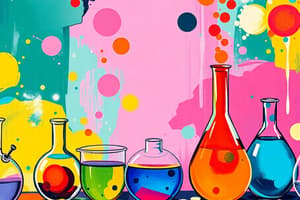Podcast
Questions and Answers
Which statement best describes the properties of metals?
Which statement best describes the properties of metals?
- High ductility and low conductivity
- Low electrical conductivity and low corrosion resistance
- High electrical conductivity and high corrosion resistance (correct)
- Low malleability and low luster
What type of bonds can carbon form with itself and other elements?
What type of bonds can carbon form with itself and other elements?
- Triple and quadruple bonds only
- Single, double, and triple bonds only
- Single, double, triple, and quadruple bonds (correct)
- Single and double bonds only
In organic chemistry, carbon primarily bonds with __________ to form hydrocarbons.
In organic chemistry, carbon primarily bonds with __________ to form hydrocarbons.
- Oxygen atoms
- Hydrogen atoms (correct)
- Sulfur atoms
- Nitrogen atoms
Photosynthesis involves converting sunlight energy into ____________ stored as glucose.
Photosynthesis involves converting sunlight energy into ____________ stored as glucose.
Which of the following is NOT a building block molecule in living organisms?
Which of the following is NOT a building block molecule in living organisms?
What is the primary function of respiration in living organisms?
What is the primary function of respiration in living organisms?
What do chemists use to describe chemical reactions quantitatively?
What do chemists use to describe chemical reactions quantitatively?
Which of the following is a characteristic of an acid?
Which of the following is a characteristic of an acid?
When sulfuric acid reacts with sodium hydroxide, what is produced?
When sulfuric acid reacts with sodium hydroxide, what is produced?
What happens when acids meet bases?
What happens when acids meet bases?
Which type of chemical compounds increases hydrogen ion concentration?
Which type of chemical compounds increases hydrogen ion concentration?
In a balanced chemical equation, what do stoichiometric coefficients indicate?
In a balanced chemical equation, what do stoichiometric coefficients indicate?
Flashcards are hidden until you start studying
Study Notes
Class 10th Science: Understanding Foundational Concepts
In your Class 10 science curriculum, you'll delve into various fundamental concepts, honing your understanding of chemistry, physics, biology, and earth sciences. In this article, we will focus specifically on some key aspects from the realm of chemical sciences—Chemical Reactions and Equations, Acids, Bases, and Salts, Metals and Non-Metals, and Carbon and its Compounds.
Chemical Reactions and Equations
A chemical reaction is a process where substances combine or separate to form new substances. To describe these reactions quantitatively, chemists employ balanced chemical equations—expressions displaying reactants and products in their simplest forms with the stoichiometric coefficients indicating the proportions present during the reaction. These equations help us predict what happens when chemicals mix together.
Acids, Bases, and Salts
Acid and base are two broad categories of compounds defined by how they interact with water and other indicators. An acid is any substance that increases hydrogen ion concentration, while a base does the opposite with respect to hydroxide ions. When acids meet bases, they produce salts containing positive hydrogen ions replaced by another cation, usually a metal ion, along with neutralization of excess H+ or OH-. For instance, when sulfuric acid reacts with sodium hydroxide, it produces sodium sulfate and water.
Metals and Non-metals
Understanding metals and non-metals helps elaborate upon differences between them in terms of properties such as conductivity, luster, malleability, ductility, and corrosion resistance. Most elements can be classified under one of these two groups depending on their characteristics. Metal alloys and compounds also play essential roles across multiple disciplines.
Carbon and Its Compounds
Carbon is perhaps the most versatile element due to its ability to bond with itself and several others through single, double, triple, and even quadruple bonds. Organic chemistry revolves around carbon, which primarily binds with hydrogen atoms forming hydrocarbons. Many other elements can link up with carbon to yield numerous compounds like carbohydrates, lipids, proteins, and nucleic acids. These organic molecules constitute building blocks required for life processes.
Life Processes
While not directly linked to the above-mentioned topics, learning life processes sheds light on the applications of chemical interactions within living organisms. Photosynthesis converting sunlight energy into chemical potential stored as glucose highlights the significance of chemical reactions in plants. Respiration utilizing cellular respiration transforms food into energy driving body functions is yet another relevant application of chemical principles in nature.
These foundational concepts pave the way for progressively more advanced subjects, providing students with a strong foundation for future studies in science and beyond.
Studying That Suits You
Use AI to generate personalized quizzes and flashcards to suit your learning preferences.




